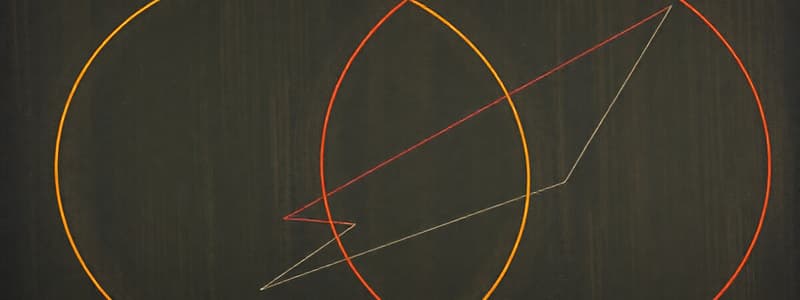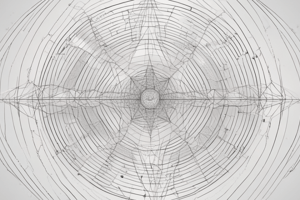Podcast
Questions and Answers
Consider a circle with inscribed angle $\angle ABC$ intercepting arc $\widehat{AC}$. A line is drawn from point $B$ to the center of the circle, $O$, creating $\angle ABO$ and $\angle CBO$. Under what specific condition, pertaining to the measures of $\angle ABO$ and $\angle CBO$, would the standard proof of the Inscribed Angle Theorem require a subtractive step, rather than a direct additive approach, to relate $m\angle ABC$ to $m\widehat{AC}$?
Consider a circle with inscribed angle $\angle ABC$ intercepting arc $\widehat{AC}$. A line is drawn from point $B$ to the center of the circle, $O$, creating $\angle ABO$ and $\angle CBO$. Under what specific condition, pertaining to the measures of $\angle ABO$ and $\angle CBO$, would the standard proof of the Inscribed Angle Theorem require a subtractive step, rather than a direct additive approach, to relate $m\angle ABC$ to $m\widehat{AC}$?
- When $m\angle ABO > m\angle CBO$ and point $O$ lies in the exterior $\angle ABC$ (correct)
- When $m\angle ABO < m\angle CBO$ and point $O$ lies in the exterior of $\angle ABC$.
- When $m\angle ABO > m\angle CBO$ and both angles are acute.
- When $m\angle ABO$ equals $m\angle CBO$ and both angles are right angles.
Given circle $\Omega$ with inscribed $\angle BAC$ intercepting arc $\widehat{BC}$, and a point $D$ on $\Omega$ such that $\angle BDC$ also intercepts $\widehat{BC}$, suppose we introduce a projective transformation that maps $\Omega$ to an ellipse $\Omega'$. How does this transformation affect the measures of $\angle BAC$ and $\angle BDC$, and what can be said about their relationship in the transformed figure?
Given circle $\Omega$ with inscribed $\angle BAC$ intercepting arc $\widehat{BC}$, and a point $D$ on $\Omega$ such that $\angle BDC$ also intercepts $\widehat{BC}$, suppose we introduce a projective transformation that maps $\Omega$ to an ellipse $\Omega'$. How does this transformation affect the measures of $\angle BAC$ and $\angle BDC$, and what can be said about their relationship in the transformed figure?
- The measures of $\angle BAC$ and $\angle BDC$ remain equal, and their equality is preserved under projective transformations because cross-ratio is invariant. (correct)
- The measures of $\angle BAC$ and $\angle BDC$ are no longer necessarily equal, but the sine of their measures will remain in the same ratio.
- The measures of $\angle BAC$ and $\angle BDC$ are no longer necessarily equal, but they are still congruent.
- The measures of $\angle BAC$ and $\angle BDC$ change, but their difference remains constant due to the properties of elliptic curves.
Consider a convex quadrilateral $ABCD$ inscribed in a circle. Under what condition, relating to the measures of the angles, can it be definitively stated that the quadrilateral $ABCD$ is a rectangle, invoking properties of inscribed angles and cyclic quadrilaterals?
Consider a convex quadrilateral $ABCD$ inscribed in a circle. Under what condition, relating to the measures of the angles, can it be definitively stated that the quadrilateral $ABCD$ is a rectangle, invoking properties of inscribed angles and cyclic quadrilaterals?
- If and only if opposite angles are supplementary and adjacent angles are complementary.
- If and only if the sum of any two adjacent angles equals $180^{\circ}$.
- If and only if all angles are equal in measure but not necessarily right angles.
- If and only if all angles are right angles because each intercepts a diameter. (correct)
In a hyperbolic plane, consider a hyperbolic triangle inscribed in a circle. How does the relationship between an inscribed angle and its intercepted arc differ from that in Euclidean geometry, and what implications does this have for the sum of angles in the hyperbolic triangle?
In a hyperbolic plane, consider a hyperbolic triangle inscribed in a circle. How does the relationship between an inscribed angle and its intercepted arc differ from that in Euclidean geometry, and what implications does this have for the sum of angles in the hyperbolic triangle?
Given two circles intersecting at points $A$ and $B$. A line through $A$ intersects the circles at $C$ and $D$, respectively. A line through $B$ intersects the circles at $E$ and $F$, respectively such that $C$, $A$, $D$ are collinear, and $E$, $B$, $F$ are collinear. What is the necessary and sufficient condition for $CE$ to be parallel to $DF$, based on properties of inscribed angles within the two circles?
Given two circles intersecting at points $A$ and $B$. A line through $A$ intersects the circles at $C$ and $D$, respectively. A line through $B$ intersects the circles at $E$ and $F$, respectively such that $C$, $A$, $D$ are collinear, and $E$, $B$, $F$ are collinear. What is the necessary and sufficient condition for $CE$ to be parallel to $DF$, based on properties of inscribed angles within the two circles?
Consider a spherical triangle $ABC$ inscribed on a sphere. How does the Inscribed Angle Theorem, which holds in Euclidean geometry, translate to the surface of the sphere, and what adjustments must be made to account for the sphere's curvature?
Consider a spherical triangle $ABC$ inscribed on a sphere. How does the Inscribed Angle Theorem, which holds in Euclidean geometry, translate to the surface of the sphere, and what adjustments must be made to account for the sphere's curvature?
Given a cyclic hexagon $ABCDEF$ where the main diagonals $AD$, $BE$, and $CF$ concur at a point $P$, formulate a condition exclusively relating the inscribed angles formed by the sides of the hexagon to ensure Pascal's theorem holds true for this configuration.
Given a cyclic hexagon $ABCDEF$ where the main diagonals $AD$, $BE$, and $CF$ concur at a point $P$, formulate a condition exclusively relating the inscribed angles formed by the sides of the hexagon to ensure Pascal's theorem holds true for this configuration.
Let $ABCD$ be a cyclic quadrilateral. Points $E$, $F$, $G$, and $H$ are the midpoints of arcs $AB$, $BC$, $CD$, and $DA$ respectively. Determine a necessary and sufficient condition, regarding the inscribed angles or arcs involving these midpoints, for $EFGH$ to be a square.
Let $ABCD$ be a cyclic quadrilateral. Points $E$, $F$, $G$, and $H$ are the midpoints of arcs $AB$, $BC$, $CD$, and $DA$ respectively. Determine a necessary and sufficient condition, regarding the inscribed angles or arcs involving these midpoints, for $EFGH$ to be a square.
Consider a complete graph $K_n$ with $n$ vertices inscribed in a circle. Edges are colored such that edges connecting vertices that are $k$ vertices apart are assigned the color $c_k$. Determine an invariant property related to the inscribed angles subtended by edges of the same color.
Consider a complete graph $K_n$ with $n$ vertices inscribed in a circle. Edges are colored such that edges connecting vertices that are $k$ vertices apart are assigned the color $c_k$. Determine an invariant property related to the inscribed angles subtended by edges of the same color.
Let $\Gamma$ be a circle and let $P$ be a point outside $\Gamma$. Let $PA$ and $PB$ be tangent to $\Gamma$ at $A$ and $B$, respectively and let $C$ be any point on the major arc $AB$. Let $T$ be the intersection of $PC$ and $\Gamma$. Determine a relationship between $\angle ATC$ and the inscribed angles formed by $A$, $B$, and $C$ that remains invariant as $C$ moves along the major arc $AB$.
Let $\Gamma$ be a circle and let $P$ be a point outside $\Gamma$. Let $PA$ and $PB$ be tangent to $\Gamma$ at $A$ and $B$, respectively and let $C$ be any point on the major arc $AB$. Let $T$ be the intersection of $PC$ and $\Gamma$. Determine a relationship between $\angle ATC$ and the inscribed angles formed by $A$, $B$, and $C$ that remains invariant as $C$ moves along the major arc $AB$.
Flashcards
Inscribed Angle
Inscribed Angle
An angle whose vertex is on a circle and whose sides contain chords of the circle.
Intercepted Arc
Intercepted Arc
The arc that lies in the interior of an inscribed angle and has endpoints on the angle.
Inscribed Angle Theorem
Inscribed Angle Theorem
The measure of an inscribed angle is half the measure of its intercepted arc.
Inscribed Angles and Same Arc
Inscribed Angles and Same Arc
Signup and view all the flashcards
Inscribed Angle & Semicircle
Inscribed Angle & Semicircle
Signup and view all the flashcards
Inscribed Triangle & Diameter
Inscribed Triangle & Diameter
Signup and view all the flashcards
Chord
Chord
Signup and view all the flashcards
Semicircle Definition
Semicircle Definition
Signup and view all the flashcards
Right Angle
Right Angle
Signup and view all the flashcards
Congruent Angles
Congruent Angles
Signup and view all the flashcards
Study Notes
- Inscribed Angle: An angle whose vertex is on a circle and whose sides contain chords of the circle.
- Intercepted Arc: The arc that lies in the interior of an inscribed angle and has endpoints on the angle.
Theorem 10.6 - Inscribed Angle Theorem
- The measure of an inscribed angle equals one half the measure of its intercepted arc.
- m∠1 = (1/2)mAB
- mAB = 2m∠1
Theorem 10.7
- If two inscribed angles of a circle intercept the same arc or congruent arcs, then the angles are congruent. ∠B ≅ ∠C because they both intercept AD.
Theorem 10.8
- If an inscribed angle of a triangle intercepts a diameter or a semicircle if and only if the angle is a right angle.
- If FJH is a semicircle, then m∠G = 90°
- If m∠G = 90°, then FJH is a semicircle and FH is a diameter.
Theorem 10.9
- If a quadrilateral is inscribed in a circle, then its opposite angles are supplementary.
- For quadrilateral KLMN inscribed in circle A:
- ∠L and ∠N are supplementary.
- ∠K and ∠M are supplementary.
Studying That Suits You
Use AI to generate personalized quizzes and flashcards to suit your learning preferences.




